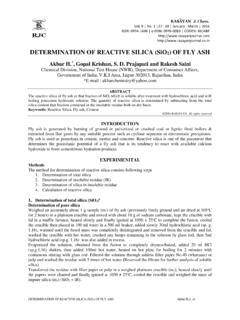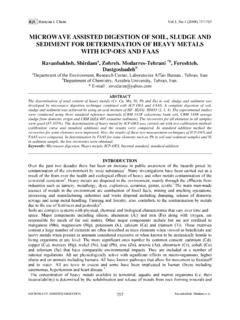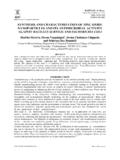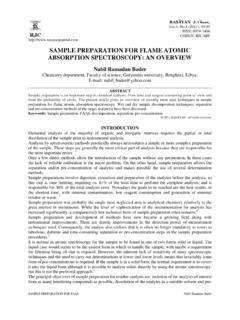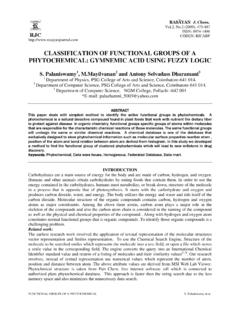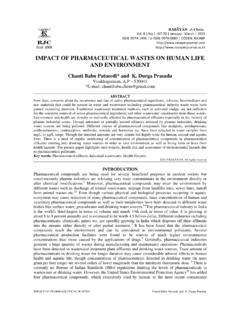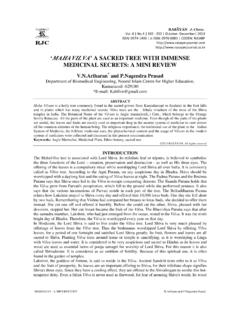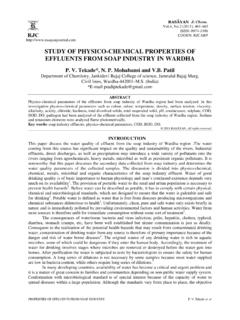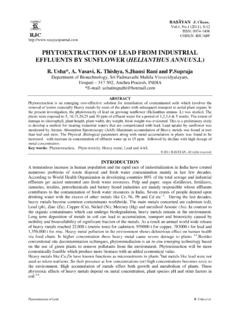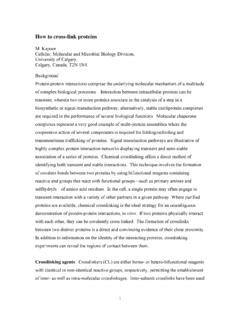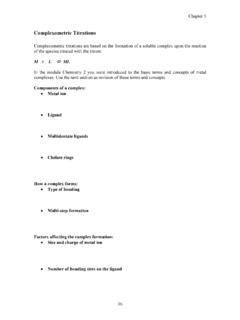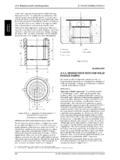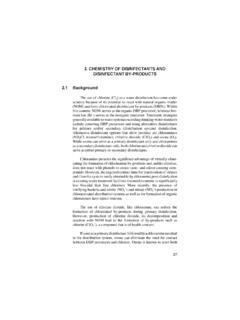Transcription of SPECTROPHOTOMETRIC DETERMINATION OF ... - …
1 RJC Rasayan J. Chem , (2008), 236-245 SPECTROPHOTOMETRIC DETERMINATION OF SODIUM LAURYL SULPHATE AS A PRIME ANIONIC SURFACTANT AND CONTAMINANT IN CENTRAL EAST CHHATTISGARH (DURG-BHILAI REGION) Santosh K. Sar*, Chanda Verma and Piyush K Pandey Department of Engineering Chemistry, Centre for Environmental Science & Engineering Bhilai Institute of Technology, Durg, Chhattisgarh, India ABSTRACT Surfactant- SPECTROPHOTOMETRIC method for Sodium Lauryl Sulphate (SLS) coupled with acridine orange (ACO) reagent has enhanced sensitivity for determining anionic surfactant (AS) contaminants, including dangerous chemicals incorporated in the ground and surface potable water through various industrial and domestic sources and has been utilized in a potentially reactive urbanized industrial site of Central East Chhattisgarh (Durg-Bhilai). This paper focuses on the potential application of the method, a patented technology, on domestic, potable, agricultural and industrial sewage waste in this potentially urbanized site (Durg-Bhilai) of Central India.
2 The study identifies the major pollutant spots the source and the points of its spread that would be helpful in identifying not only the potential sources of contamination but also the reasons embarking the mobility of the surfactant spread. Further this work also tends to determine the viability of these potential applications as applied to a large area. Key Words :Spectrophotometer , Sodium Lauryl Sulphate, Durg-Bhilai, Waste Water INTRODUCTION With the advent of detergents during the late 50s a major revolution of surfactants took place. Detergents act as both sequesters as well as surfactants. Surfactants are surface-active substance that lowers the surface tension of the solvent. With a hydrophobic group bearing a radical of 10-20 carbon atoms and a hydrophilic moieties ionic or nonionic depending upon the type of surfactant1 they attain a pseudo-level of self-association called micelle2 beyond a particular level of surfactant concentration critical micelle (CMC) which actually is the responsible factor for the cleansing action of the surfactants.
3 The various classes of surfactants ionic surfactants including both anionic and cationic constitute approximately two-third of the various surfactants, 90% of which is mainly contributed by anionic surfactants. Among various anionic surfactants SLS is a widely used anionic surfactants used in modern times by most of the countries. Being an anionic surfactant, known for its strong detergent properties, structurally one end of the molecule is charged and therefore has an affinity for water, and the other end is non-polar and soluble in fats/oils. SLS has a negatively charged sulfonate group as its hydrophilic end and a saturated 12-carbon chain for its lipophilic end. SLS has a faint odor of fatty substances and at room temperature, occurs as white or cream-colored crystals, flakes, or powder3, or a clear to SPECTROPHOTOMETRIC DETERMINATION OF SODIUM LAURYL SULPHATE Santosh K. Sar*et al. RJC Rasayan J.
4 Chem , (2008), 236-245 yellowish thick fluid. SLS is stable under ordinary conditions of use and storage but is incompatible with strong acids or strong oxidizing agents 4. No specific information was located regarding the mode of action of SLS as an herbicide. In general, the principle value of soap-based herbicides (like SLS) is in their capacity to penetrate green plant tissue and disrupt cellular structure, leading to dehydration and eventual death 5. In general, the major use of SLS is as a synthetic chemical surfactant1 for emulsion polymerization6. Other major uses include the following: in the electroplating industry as an emulsifier; as a wetting agent and adjuvant in insecticides; as an emulsifier and penetrate in varnish and paint remover; in the formulation of injection-molded explosives; as a model surfactant and reference toxicant in aquatic and mammalian toxicological testing; as a whipping agent and surfactant in foods; and as a cleaning agent in a wide variety of personal care products, such as toothpastes, shampoos, bubble baths, shaving creams - any product that requires a thickening effect and the ability to create a lather.
5 HPD (2004) lists7 household products that include SLS. SLS is included as one of 31 Active Ingredients which may be in minimum risk pesticide products which are exempt to Section 25(b) of the Federal Insecticide, Fungicide, and Rodenticide Act (FIFRA)8-9. SLS is included as one of more than 3,000 total substances that together comprise an inventory often referred to as Everything Added to Food in the United States (EAFUS) 10 determined by the Food and Drug Administration (FDA)10 Center for Food Safety and Applied Nutrition (CFSAN)10. Although environmental impacts regarding pollution from SLS are not direct but indirectly it affects the biological cycle. This paper presents a patented method of identifying the potential spots of SLS contamination as a major anionic surfactant in newly formed Chhattisgarh state and its environmental impacts relating to a accelerated urbanization and industrial development in the studied spot in the recent years.
6 EXPERIMENTAL 10 mL Samples solution to which 100 L of Acridine Orange (5 x 10 -3M) and 100 L of glacial acetic acid was added, and the resultant was extracted with 5 mL of toluene, shaken for 1 minutes and allowed to stand for 5 min. followed by isolation of the organic layer and its subsequent measurement at 467 nm spectrophotometrically systronic 105. A calibration curve was obtained for SodiumDo-Decyl sulphate concentration ranging from to 6 ppm for which a fluorescent yellow colour layer was obtained. Sampling and Analysis. Various water samples from contaminated area including sites of drained industrial out flows and domestic sewage samples were collected in eight portions of 100 cm3 of sample at a distance in Erlenmeyer flasks respectively and the temperature and pH were simultaneously recorded. The flasks were incubated at 250C and the total amount of SLS in each flask was determined. The SPECTROPHOTOMETRIC DETERMINATION OF SODIUM LAURYL SULPHATE Santosh K.
7 Sar*et al. RJC Rasayan J. Chem , (2008), 236-245 relative degradation of the concentration was also simultaneously investigated with the same river water sample at the same time. The beaker was incubated at 25 cube/30 revs min21. Investigation of SLS concentration was carried under three major demarcated sites. 1. Source of outflow of the industrial and sewage waste. 2. Place of accumulation of the dumped sewage. 3. Ground water near the source of accumulation. RESULT AND DISCUSSION The outcome of the three major categories of contaminant source of SLS (Table 1) revealed that the extent of SLS usage was more widespread in domestic and industrial waste as compared to agricultural waste. A negative degree of kurtosis in domestic sewage waste as compared to the other two was also indicative of the fact that the uniform application of the chemicalwas more in the later than in the former case.
8 Monitoring the SLS concentration in sixteen major flowing sewage streams during 2006 to 2007 (Table 2) showed that with values showing a wide degree of variation maximum of ppm to as low as ppm, the Percentage deposition of SLS during dumping was higher as compared to that during flowing as revealed in Apart from the factors of flow rate and TDS, a flowing condition was associated with different anionic exchanges and other parameters of water which showed the following results as shown in Depending upon their SLS concentration in the sampling streams of heavily drained sites from industrial wastes and garbage domestic wastes were segregated and their SLS concentrations were separately monitored according to their location of source, area of their downstream flow which include 16 substations each 2 kms apart from each other and area of their dumping and their concentration determined as shown in Table 2. These values showed a marked variation in the SLS concentration with outflow from the source and their ultimate drainage in to the sink.
9 The sedimentation rate of SLS during flow and after dumping indicated a significant value of SLS is deposited during dumping rather than during flow which in turn may be a probable reason for a high value of SLS concentration in the nearby ground water source near the dumping sink site of the stream rather than near the flow site as is evident in the SLS concentration values of ground water of bore holes and wells sampled near the dumping site. Estimation of other water parameters shown in fig. including Sulphate, chloride, dissolved Oxygen, alkalinity and pH reveals that for a mean pH variation SLS concentration varied significantly with Total alkalinity, chloride and dissolved oxygen. While the Sulphate change showed negative correlation with the SLS concentration shown in The correlation is an indicative that SLS concentration in the solution might be showing ion displacement reactions with prominent ions like Sulphate or SPECTROPHOTOMETRIC DETERMINATION OF SODIUM LAURYL SULPHATE Santosh K.
10 Sar*et al. RJC Rasayan J. Chem , (2008), 236-245 HCO3-, CO3--, Cl- or OH-, the dissolved oxygen in turn provides necessary oxidizing or reducing conditions for this variation. This fact is strongly supported by analyzing the depth variation of SLS with DO shown in fig 2 which indicated that while the SLS concentration was more in the depth than in surface the dissolved oxygen showed a negative correlation with both distance from the surface and also with the surfactant. Correlation statistics indicated that while major studied water parameters behaved correlatively with the surfactant, mainly dissolved oxygen and chloride varied reciprocally to the surfactant concentration. This might be strong indicative of the fact that anions including Sulphate, HCO3-, CO3--, or OH- may serve for the ion exchange reaction catalyzed by opposing behavior of chloride conditions due to variation of SLS concentration with other water parameters is shown in and Correlation study of SLS with other studied water parameters however revealed that while the DO and chloride concentration varied significantly with depth a might be major factors for varying SLS concentration, uniform replicate study of these parameters in different stations revealed that the surfactant variation was reciprocally related with Sulphate while rest other parameters excluding chloride showed a almost same correlative behavior as with depth.
